Inside Out
Three artists explore the changing relationship among the individual, the city and the home
 Poorna Swami
Poorna Swami
 Poorna Swami
Poorna Swami
 |
12 Jun, 2020
|
12 Jun, 2020
/wp-content/uploads/2020/06/Insideout1.jpg)
A digital drawing for lenticular print from Pause in a Flicker by Tanya Goel (Courtesy: Tanya Goel and Nature Morte)
TO WANDER THE city has become an illicit trade. We are advised to step out only for essential activities, perhaps for a quick bout of daily exercise—but no dawdling! To walk with no other purpose than to look upon the passing hours of the city has become for many a constant hankering. The unevenness of pavements, the stench of the fish market, conversations overheard at cafes without permission—these days, what we experience of city life and how we experience it have altogether changed.
Browsing through Tanya Goel’s exhibition Pause in a Flicker, now on display online at Delhi’s Nature Morte gallery, stirs a strange sensation. The images reveal fragments of Delhi from up close, and yet the city seems to appear only as its own ghost. Goel’s exhibition is a reworking of her largescale installation designed for Art Dubai 2020. The installation comprises several lenticular prints, ‘the type of photograph, usually used in commercial and promotional contexts, which changes as one moves past it, revealing multiple images within a single frame’. For the version of the work displayed in the digital ‘viewing room’on Nature Morte’s website, Goel has created digital drawings of the lenticular prints, rather than simply displaying photographs of the prints themselves. “Something I was very firm about,” she says, “was that if I am going to do a virtual show, I wanted it to be something… that was created specifically for a virtual experience.” On a computer screen, each image changes its appearance, depending on where you move your cursor. Goel says she was trying to simulate the physical experience of viewing a lenticular, in which you have to move your body from left to right to see the image differently.
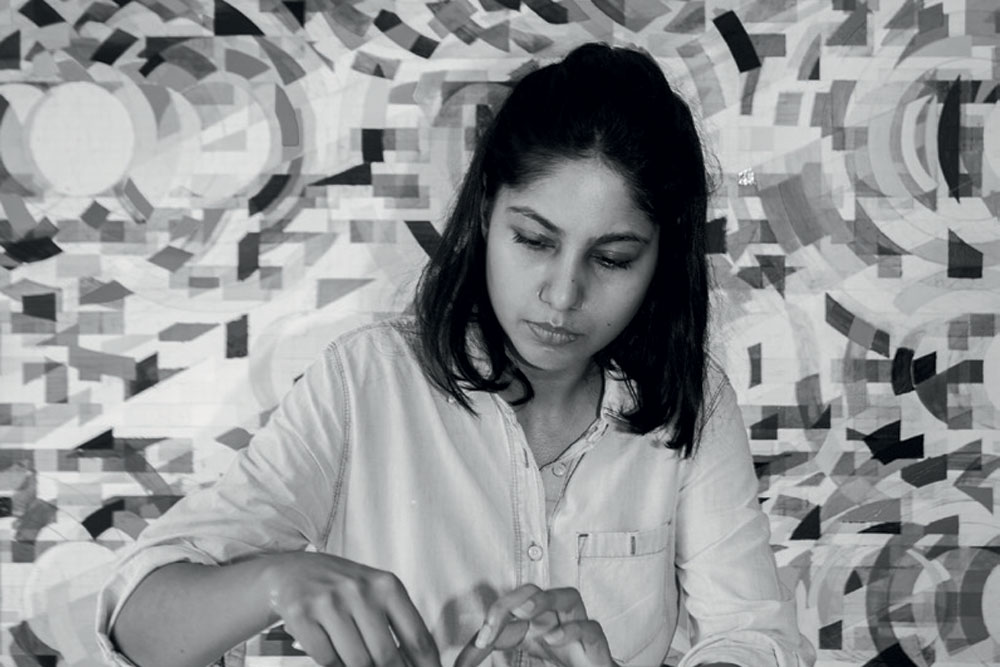
Beneath the debris of abstracted architectural forms, both opaque and translucent, photographic hints of the city emerge. A dahlia in Sunder Nursery. An archway of an unnamed monument framing the silhouette of two idlers. These sites form and dissolve within a blanket of triangles and squares—we never see them clearly. Goel has long been interested in how we see colour. Before the lockdown, she often walked around the city collecting samples from demolition sites and then would break the samples down to their component pigments: cement, brick, tile. Citing Goethe’s theory of the afterimage, she says she is interested in how we see new images with the remnants of something we have seen earlier still etched in our minds. The lenticular, with its shifts in colour, allows her to give this idea form.
“Cities are built. And everything that is in them is also landscaped and manufactured. The gardens, the roundabouts, even nature is an architectural element,” says Tanya Goel, artist
In the viewing room, without walking through the city, we still sense it somehow. We see the deceit in its colours. The discomfiture of its arrangement. The tenderness within its concrete skeleton. For Goel, the city’s architecture is manifold. “Cities are built,” she says. “And everything that is in them is also landscaped and manufactured. The gardens, the roundabouts… even nature is an architectural element.” It isn’t that Goel’s images, manufactured themselves, recreate familiar landscapes. Carefully abstracted visions, these instead offer us associations, visual pieces that are distinctly made of urban materials and yet not identifiable as any particular location.
As the images themselves change with our own movement, we are forced to pause and look at them and look again. At the same time, we face the odd conundrum of being dislocated from both the artwork and its subject. The gallery space is itself flattened into a two-dimensional experience. From within an animated simulation of a white cube on our screens, we navigate an abstracted archive of the city, stripped of the familiar experience of sensing it through sound, smell and proprioception. With each change of gaze, we reorganise in our minds the city’s transience, searching for in-roads back to cover the distances.
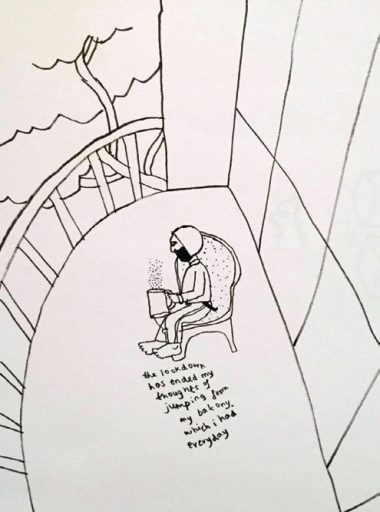
For Mumbai-based visual artist Prajakta Potnis, this sudden distancing of the physical body from the city during mass quarantine has forced her to reassess a fundamental relationship in her work: that among the individual, the city and the home. In March, Potnis won the Prameya Art Foundation’s Artist in Residence award, under which she was to work on a project in Paris, supported by Cité Internationale des Arts and Institut Français. The three-month residency was to begin in July, but has been postponed indefinitely due to the Covid-19 pandemic.
“I started to draw on the windows, hang wires in my balcony and put up works. The balcony was like an open studio where I painted from 2 at night to 5 in the morning,” says Gagan Singh, artist
The project that Potnis had proposed was based on what was a simple idea of walking through the city and looking at it. Her starting point was French writer Charles Baudelaire’s 1863 essay ‘The Painter of Modern Life’, in which he imagines a character now ingrained in the history of art. The flâneur, a person who strolls through the city, observing its every detail without ever interfering, is a persona that has been taken on by artists and writers alike. Although one among the crowd, the flâneur never assimilates into the crowd. In 2012, during another residency in Paris, Potnis had taken on the role of the flâneur to create a work titled room full of rooms. In 2020, her plan had been to build on that work.
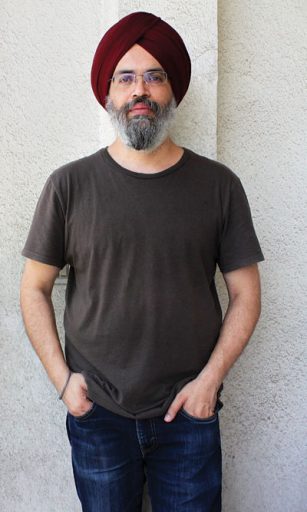
Finding the almost blasé gaze of Baudelaire’s flâneur problematic, Potnis chose to gaze at Paris through the eyes of the people who inhabited it. She says, “Who looks at whom comes with a lot of layers. Who is that eye who is casually walking through the city?” For Potnis, flâneuring became a way of asking questions around privilege and integration, particularly because she focused on Parisians who had moved to the city from elsewhere. One of her main subjects was the home of an Algerian man. “A brown woman or black man walking down the street might not be able to do so without constantly looking over their shoulder,” she says.
While the archetypal flâneur inhabits the streets, Potnis connected the public spaces of the city with the privacy of the home. She walked into people’s homes, asked to photograph their possessions and also the view from their window. It was a way of taking on their gaze of the city. Even during the recent lockdown, Potnis says, “The window is our immediate access to the outside world, beyond our screens. You look and wonder for how long people will be wearing masks… You see the migrants and you see your own privilege.”
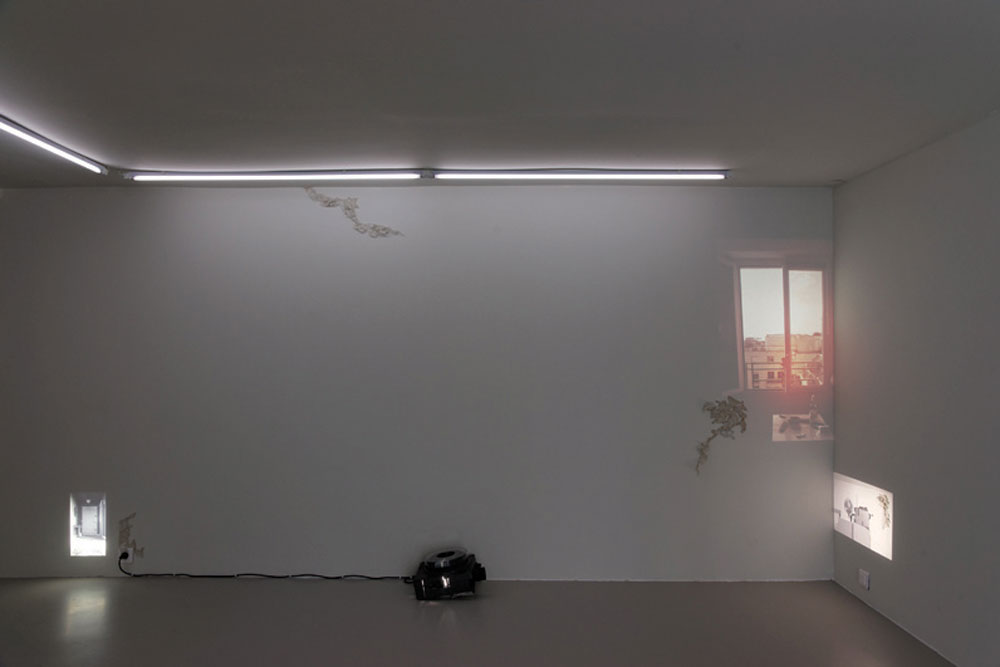
In a gallery, four slide projections of four persons’ homes play. On the walls, a collage of French and Chinese-made lace create the impression of peeling walls.
The four walls of the gallery themselves signify different kinds of borders and assimilations. The borders between the shelter of the home and the exposure of the city. The fragile ways in which people carry their home with them and how, in doing so, they perhaps remake the city itself.
Although she had anticipated returning to this work with her original method of documentation, Potnis explains that the lockdown in Mumbai has made her “anxious to rethink” this Paris-based work. “The project was so tactile,” she says. “Now, you don’t know how people will react to someone wanting to come into their home.” But another conceptual concern that has arisen for her is what the home and the city mean for each other after this period of immense change. As people have been pushed into their homes because of the pandemic, many have struggled to even reach their homes, while others still have been stuck in toxic homes, she points out. In India, she feels that the home has also become a site of nationalist agenda in recent months. “From their homes, people were clapping and lighting lamps to serve specific political interests,”she says.
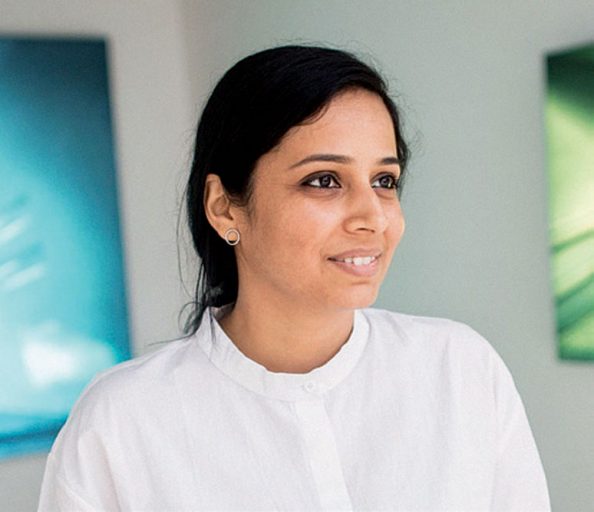
Potnis views this time in which people have been pulled away from the streets as one of many “slippages”. A time when the absence of the physical body from city streets has come with political implications. She says of the lockdown, “There are all these arrests of students and people who dissent. And a lot of it is under-reported. And you can’t do much about it. You are no longer allowed to put your body out there. The body is often all you have to stop something from happening.” Potnis’s latest exhibition, A Body without Organs, which deals with the body and capitalism, is currently on display on the website of the Mumbai gallery Project 88.
While Potnis continues to contemplate our changed relationships within cities with an outward gaze, Delhi-based artist Gagan Singh found himself turning inward during the lockdown. Earlier, his practice had relied on long walks around the city. He says, “I like walking to a market for kilometres… have a coffee and come back.” During his sojourns, he would find a cafe in which to sit down and draw what he was thinking. But that ritual changed suddenly once the lockdown was announced. “I could not go beyond the balcony,” he says.
“A brown woman or black man walking down the street might not be able to do so without constantly looking over their shoulder,” says Prajakta Potnis, artist
The unexpected restrictions on movement stoked what Singh describes as “mental sufferings”. Inside his home, he had to care for his mother who had broken her leg, and outside, lay a fear of contagion. To deal with these sufferings, he began to draw scenes based on his new home-contained life. Without the city to serve as inspiration, he says he felt a “total loss”, a sense of having public spaces “taken away” by the law. So his home invariably became his primary site. “I started to draw on the windows, hang wires in my balcony and put up works,” he says. “The balcony was like an open studio where I painted at 2 AM at night to 5 AM in the morning.”
A selection of Singh’s drawings are on display on the website of the Mumbai gallery Chatterjee & Lal with the title Drawings Made during Lockdown. Each drawing is a small pen illustration centred on a figure that resembles Singh himself. Predominantly black-and-white, the drawings are occasionally accented with a stroke of red or orange. Singh says he returned to materials he had not touched for more than a decade. “Dried-up coloured inks, watercolour, paper rolls, I started to consume everything,” he says.
Although the drawings are a way for the artist to work through ‘sufferings’, they are also obviously funny—silly even. In one drawing, he has sealed everything from the sink to the dog to himself in protective plastic. For Singh, humour is “a way to mock something, thereby critiquing the viewers gaze”. Even though his mother was crying in pain, he chose to make the drawing about her “passing gas”. To rely on humour during distress became both a coping mechanism and a means of commentary. Singh says, “I drew on a banana as the best way to explain the curve which every country was trying to flatten. I guess humour defuses tension.”
The limited scope of Singh’s drawings is striking. He doesn’t look beyond his balcony but instead obsesses over domesticity and its mundaneness. He explains this as a reflection of his current moment. During the lockdown, the city came to be defined for him in terms of its restrictions: colour-coded zones, curfew timings, closures. That in turn limited his source materials and so he resigned to a narrower palette.
Displeased as he seems with these changes, he has also begun to think about the nature of the city that was at the heart of his daily practice. He now wonders if the city as a site inherently lends itself to control.“Maybe that’s why you call it a lockdown,” he says, “you can lock it. You can’t do it to a forest. In a forest, you would just run away.”

/wp-content/uploads/2025/01/Cover_Kumbh.jpg)












More Columns
What does the launch of a new political party with radical background mean for Punjab? Rahul Pandita
5 Proven Tips To Manage Pre-Diabetes Naturally Dr. Kriti Soni
Keeping Bangladesh at Bay Siddharth Singh